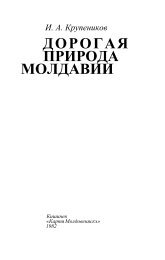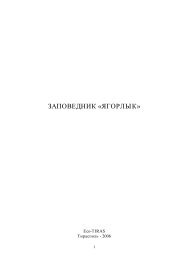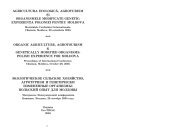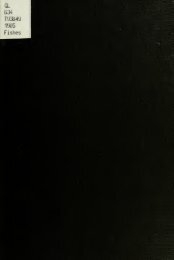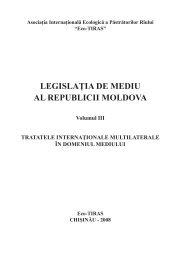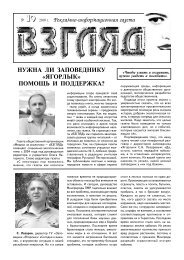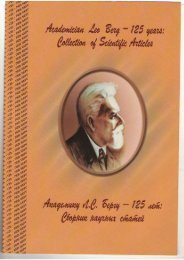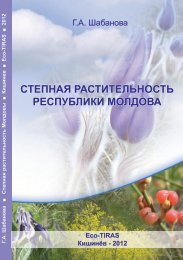Рис. 1. Связь устойчивого туризма и устойчивого развитияонирования в бассейне реки Днестр – вот важнейшаязадача, требующая партнерства, сотрудничества исинергии, для обеспечения благосостояния нынешнихи будущих поколений.Литература1. Angheluţă Vădineanu. Dezvoltarea durabilă. Volumul I. Teorie şipractică. Editura universităţii din Bucureşti 1998;2. Angheluţă Vădineanu. Dezvoltarea durabilă. Volumul II.Mecanisme şi instrumente. Editura universităţii din Bucureşti 1999;3. Valeriu Rusu. Dezvoltarea durabilă-speranţa comunităţilor şigeneraţiilor. Editura „Mediul ambiant”. Chişinău 2002;4. Valeriu Rusu. Rezervaţiile peisagistice nistrene: Ţâpova,Saharna, Poiana Curătura şi Climăuţii de Jos; Editura „Mediul ambiant”.Chişinău 2002.5. Vasile Glăvan, Nicolae Platon, Valeriu Rusu. Managementulturismului rural în Republica Moldova: probleme, realităţi şi perspective.Editura „Bons-Offices”. Chişinău 2004.6. Valeriu Rusu. ABC-ul turismului rural, ecologic şi cultural.Tipografia „Reclama”. Chişinău 2002.7. Svetlana Rusu, Jacek Wesierscki. Produse tradiţionale localedin Moldova. SRL „Cu drag”. Chişinău 2008.8. Доклад Конференции Организации Объединенных Нацийпо окружающей среде и развитию, Рио-де-Жанейро, 3–14 июня1992 года, том I, Резолюции, принятые Конференцией (изданиеОрганизации Объединенных Наций, в продаже под № R.93.I.8 и исправление),резолюция 1, приложение II.9. Резолюция S-19/2 Генеральной Ассамблеи.10. “A Practical Guide for the Development and Application ofIndicators of Sustainable Tourism” (World Tourism Organization,1996).— 191 —
PECULARITIES OF DYNAMICS OF PHOSPHORUS FORMS IN WATER,PARTICULATE MATERIALS AND BOTTOM SEDIMENTS OF RIVER DNIESTERV. Rusu, L.Postolachi, T. LupascuInstitute of Chemistry of Academy of Sciences of Moldova, Lab of <strong>Eco</strong>logical Chemistry, Academiei 3 str, MD-2028 Chisinau, Moldova, E-mail:larisapostolachi@rambler.ruSeasonal and spatial dynamics of phosphorus forms in water, particulate materials and bottom sediments of river Dniester was elucidated. Thescheme for determination of phosphorus forms in water and particulate materials according to World Health Organization classification was completedand tested for estimation of phosphorus forms in bottom sediments. Dynamics recorded during 2009 agree well with ones established during 2004.IntroductionPhosphorus compounds constitute nutrients whichstimulate growth of hydrobionts population in water bodies.In large quantities phosphorus compounds have fertilizingeffect, affecting both water quality and entirely ecosystem.Thus, monitoring of phosphorus content in natural watersrepresents essential issue for protection and rational utilizationof aquatic resources. Monitoring of phosphorus contentin the aquatic environment is very important, consequentlyphosphorus compounds are introduced in list of dangeroussubstances discharged into the aquatic environmentof the European Community. Thus, according to Directive2006/11/EC [1], the organic-phosphorus compounds areintroduced in Annex I, List I, and inorganic compounds ofphosphorus – in List II of this directive.According to World Health Organization (WHO), phosphoruscompounds occurred in natural waters are classifiedinto 12 phosphorus forms, by chemical type – (i) orthophosphates,(ii) acid hydrolysable phosphates, (iii) organic-phosphorus,(iv) total content, and by physical state – (i) dissolved(filterable), (ii) particulate, (iii) total content [2].Additionally, this scheme was tested for estimation ofphosphorus content in bottom sediments being determined(i) inorganic phosphorus (orthophosphate plus condensedforms – polyphosphates and pyrophosphates), (ii) organic-phosphorus and (iii) the total amount of phosphorus [3].Thus, the supplemented scheme allows the analysis of thephosphorus forms for the entirely system “water – particulatematerials – bottom sediments”, considerably extendingpossibilities for interpretation of phosphorus dynamics innatural waters. This scheme was applied for evaluationof phosphorus dynamics for lakes from Chisinau [4], forresearch of seasonal and spatial dynamics of phosphorusfor river Dniester during 2004 [5, 6], and for river Prut [3].Case studySamples of water, particulate materials and bottom sedimentswere collected during 2009 along river Dniester (sitesOxentia, Malovata and Vadul-lui-Voda). Contents of phosphorusforms in water and particulate materials were determinedusing methods according to World Health Organization classification[2]. To determinate total phosphorus (form P<strong>13</strong> infig. 1) in bottom sediments, fresh (wet) samples were used,and oxidative hydrolyze in acid medium in presence of ammoniumperoxodisulfate was realized. Inorganic phosphorus(form P14 in fig. 1) in bottom sediments was determinateusing hydrolyze in acid medium in severity-moderate condition.The amount of organic phosphorus (form P15 in fig. 1)is obtained by subtracting inorganic phosphorus (P14) fromthe amount of total phosphorus (P<strong>13</strong>).Fig. 1. Phosphorus forms in natural waters for the entirely system “water-particulate materials-bottom sediments”.Supplemented scheme for analysis of the phosphorus forms in water and particulate materials accordingto World Health Organization classification (forms 1-12) and in sediments (forms <strong>13</strong>-15).— 192 —
- Page 3 and 4:
Descrierea CIP a Camerei Nationale
- Page 5 and 6:
Уважаемые коллеги,
- Page 7 and 8:
щегосударственной
- Page 9 and 10:
доме, в котором мы в
- Page 11 and 12:
шие глубины на заде
- Page 13 and 14:
с малыми восстанов
- Page 15 and 16:
Литература1. Жадин
- Page 17 and 18:
Рис. 3. Многолетняя
- Page 19 and 20:
тера и глубины изме
- Page 21 and 22:
ПОДДЕРЖАНИЕ БИОРАЗ
- Page 23 and 24:
Таблица 5. Оптималь
- Page 25 and 26:
Таблица. Результат
- Page 27 and 28:
ФОРМИРОВАНИЕ БИОЦЕ
- Page 29 and 30:
Подавляющее больши
- Page 31 and 32:
Рис.1. Днестр вблизи
- Page 33 and 34:
сопоставимости дан
- Page 35 and 36:
ции с международны
- Page 37 and 38:
А.Н. Бургеля, К.П. Бу
- Page 39 and 40:
Выводы1. Уже на само
- Page 41 and 42:
тегории, виды и пор
- Page 43 and 44:
санитарно-эпидемио
- Page 45 and 46:
Таблица 4. Распреде
- Page 47 and 48:
реационных, монито
- Page 49 and 50:
Шабановой Г.А. и Кух
- Page 51 and 52:
могут быть убраны,
- Page 53 and 54:
Турунчук. Связь с с
- Page 55 and 56:
Праздник «День Рек
- Page 57 and 58:
500ЈPРис. Распределе
- Page 59 and 60:
Н. Гроссу * , Р. Шакир
- Page 61 and 62:
Рис.1. Помесячное ра
- Page 63 and 64:
Calitatea apei r. Nistru conform gr
- Page 65 and 66:
Карта геохимическо
- Page 67 and 68:
лесу был дуб, сегод
- Page 69 and 70:
При предварительно
- Page 71 and 72:
щих улучшить социа
- Page 73 and 74:
ней опасных загряз
- Page 75 and 76:
ФотоприложениеФот
- Page 77 and 78:
в Украине - одесска
- Page 79 and 80:
тия по гидрохимиче
- Page 81 and 82:
ветствующих санита
- Page 83 and 84:
ния полей, так и для
- Page 85 and 86:
В. Экономический ан
- Page 87 and 88:
Таким образом, плат
- Page 89 and 90:
Рис. 2. Динамика нор
- Page 91 and 92:
Табл. 1а. Статистиче
- Page 93 and 94:
Выводы1. Наибольшее
- Page 95 and 96:
Для днестровской в
- Page 97 and 98:
ЭКОЭТИЧЕСКОЕ ВОСПИ
- Page 99 and 100:
Таблица 1. Валовое с
- Page 101 and 102:
почвенный покров п
- Page 103 and 104:
always been the public concern of b
- Page 105 and 106:
и уникальными по си
- Page 107 and 108:
ются основными фак
- Page 109 and 110:
Рис. 4. Пораженность
- Page 111 and 112:
ight to use”. Varone et al. (2002
- Page 113 and 114:
mass media, etc., which belong to d
- Page 115 and 116:
В связи с тем, что К
- Page 117 and 118:
период поездки вых
- Page 119 and 120:
doutchinae (d’Orb.), выше з
- Page 121 and 122:
вместе с осадками в
- Page 123 and 124:
Таблица 4. Содержан
- Page 125 and 126:
efectuat în baza următorilor indi
- Page 127 and 128:
видуальных различи
- Page 129 and 130:
- соответствующее з
- Page 131 and 132:
ФАУНА КЛЕЩЕЙ ДРЕВЕ
- Page 133 and 134:
Таблица 1. Данные ра
- Page 135 and 136:
РЕКРЕАЦИОННЫЕ РЕСУ
- Page 137 and 138:
ЭТАПЫ ЭВОЛЮЦИИ БИО
- Page 139 and 140:
Плотина Дубоссарск
- Page 141 and 142: чимые. При этом «пе
- Page 143 and 144: Схематически получ
- Page 145 and 146: Таблица 5. Данные на
- Page 147 and 148: Risks for biodiversity with tested
- Page 149 and 150: 14. Ярошенко M.Ф., Дед
- Page 151 and 152: 20082009Fig. 2. Structure of shrew
- Page 153 and 154: с природой (различн
- Page 155 and 156: делить в их предела
- Page 157 and 158: Таблица. Оценка эне
- Page 159 and 160: лах Приднестровья
- Page 161 and 162: ВыводыКраеведческ
- Page 163 and 164: вий среды жизнедея
- Page 165 and 166: Senecio besserianus Minder. Cypripe
- Page 167 and 168: Рис.1. Почвенная кар
- Page 169 and 170: половины площади п
- Page 171 and 172: Рис. 2. Современное
- Page 173 and 174: ПРИЧИНЫ ГЕОМОРФОЛО
- Page 175 and 176: RÂURILE MICI CU ŞANSE MARIDE A FI
- Page 177 and 178: ЭКОНОМИКО-ЭКОЛОГИЧ
- Page 179 and 180: прибрежной зоной (п
- Page 181 and 182: Строительство в пр
- Page 183 and 184: государственного у
- Page 185 and 186: ческий, социальный
- Page 187 and 188: ми, послужило весом
- Page 189 and 190: губительно влияющи
- Page 191: ных за контролем и
- Page 195 and 196: Fig. 4. Spatial and seasonal dynami
- Page 197 and 198: • inventory of point discharges s
- Page 199 and 200: СТЕРИЛИЗАЦИЯ КАК С
- Page 201 and 202: гормоны (в незначит
- Page 203 and 204: ПРОТОКОЛ ПО ПРОБЛЕ
- Page 205 and 206: воды ежегодно умир
- Page 207 and 208: РАЗРАБОТКА ПЛАНОВ
- Page 209 and 210: ставляет материаль
- Page 211 and 212: • Совершенствован
- Page 213 and 214: «Алые паруса». Таки
- Page 215 and 216: which the Committee is then require
- Page 217 and 218: нием, культурой и х
- Page 219 and 220: - Николаевская церк
- Page 221 and 222: Сброшенный на 50 м б
- Page 223 and 224: СТРУКТУРА ГЕОИНФОР
- Page 225 and 226: 4. Пространственная
- Page 227 and 228: На фазе пика числен
- Page 229 and 230: А.А. Тищенков, В.В. М
- Page 231 and 232: Распределение видо
- Page 233 and 234: цветковый (ККП, ЧКУ,
- Page 235 and 236: очередной задачей
- Page 237 and 238: схемой планировани
- Page 239 and 240: эксплуатационным п
- Page 241 and 242: ных дамб, с возвращ
- Page 243 and 244:
ледствия от урбани
- Page 245 and 246:
ОСНОВНЫЕ ФОРМЫ ДЕГ
- Page 247 and 248:
УЧАСТИЕ НЕПРАВИТЕЛ
- Page 249 and 250:
струкции как от сбр
- Page 251 and 252:
Рогоз широколистны
- Page 253 and 254:
Таблица 3. Изменени
- Page 255 and 256:
В рамках первых тре
- Page 257 and 258:
Основные экскурсио
- Page 259 and 260:
2. Кравченко Е.Н. При
- Page 261 and 262:
Decision-Maker user group are respo
- Page 263 and 264:
может ее запускать,
- Page 265 and 266:
поражения населени
- Page 267 and 268:
тию РДЮЦ «ГУТТА - кл
- Page 269 and 270:
мость разработки н
- Page 271 and 272:
Биология. Подорожн
- Page 273 and 274:
банизированных тер
- Page 275 and 276:
Результаты исследо
- Page 277 and 278:
площадь ассимиляци
- Page 279 and 280:
Рис. 3. Дендрограмма
- Page 281 and 282:
Рис.1. Сезонная дина
- Page 283 and 284:
Молдовы и Приднест
- Page 285 and 286:
Ребята приехали в 10
- Page 287 and 288:
Рис. 1. Численность
- Page 289 and 290:
жений, в том числе э
- Page 291 and 292:
[4]. Несомненно, выжи
- Page 293 and 294:
КОНСТИТУЦИОНАЛЬНА
- Page 295 and 296:
В настоящее время б
- Page 297 and 298:
8. Суворцева В.Ю., Ру
- Page 299 and 300:
Окончание табл. 2Ок
- Page 301 and 302:
содержаниеПРЕДИСЛ
- Page 303 and 304:
А.П. Погребняк, В.Ф.
- Page 305:
Научное изданиеБАС


![[download]13,2 Mb - Eco - Tiras](https://img.yumpu.com/50284532/193/500x640/download132-mb-eco-tiras.jpg)
